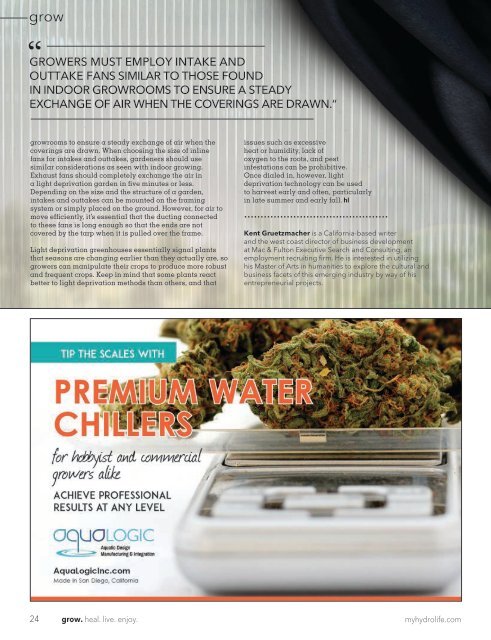Hydrolife Magazine April/May 2017 (USA Edition)
To know where you’re going, you have to know where you’ve been. The same adage rings true for the modern cannabis industry, which is why this issue of Hydrolife takes a look back at the roots of marijuana and how the plant has traveled through history (History of Cannabis Part II), as well as how the industry may be affected by recent political appointments (Should the Cannabis Industry be Worried?)
To know where you’re going, you have to know where you’ve been. The same adage rings true for the modern cannabis industry, which is why this issue of Hydrolife takes a look back at the roots of marijuana and how the plant has traveled through history (History of Cannabis Part II), as well as how the industry may be affected by recent political appointments (Should the Cannabis Industry be Worried?)
Create successful ePaper yourself
Turn your PDF publications into a flip-book with our unique Google optimized e-Paper software.
grow<br />
“ GROWERS MUST EMPLOY INTAKE AND<br />
OUTTAKE FANS SIMILAR TO THOSE FOUND<br />
IN INDOOR GROWROOMS TO ENSURE A STEADY<br />
EXCHANGE OF AIR WHEN THE COVERINGS ARE DRAWN.“<br />
growrooms to ensure a steady exchange of air when the<br />
coverings are drawn. When choosing the size of inline<br />
fans for intakes and outtakes, gardeners should use<br />
similar considerations as seen with indoor growing.<br />
Exhaust fans should completely exchange the air in<br />
a light deprivation garden in five minutes or less.<br />
Depending on the size and the structure of a garden,<br />
intakes and outtakes can be mounted on the framing<br />
system or simply placed on the ground. However, for air to<br />
move efficiently, it’s essential that the ducting connected<br />
to these fans is long enough so that the ends are not<br />
covered by the tarp when it is pulled over the frame.<br />
Light deprivation greenhouses essentially signal plants<br />
that seasons are changing earlier than they actually are, so<br />
growers can manipulate their crops to produce more robust<br />
and frequent crops. Keep in mind that some plants react<br />
better to light deprivation methods than others, and that<br />
issues such as excessive<br />
heat or humidity, lack of<br />
oxygen to the roots, and pest<br />
infestations can be prohibitive.<br />
Once dialed in, however, light<br />
deprivation technology can be used<br />
to harvest early and often, particularly<br />
in late summer and early fall.<br />
Kent Gruetzmacher is a California-based writer<br />
and the west coast director of business development<br />
at Mac & Fulton Executive Search and Consulting, an<br />
employment recruiting firm. He is interested in utilizing<br />
his Master of Arts in humanities to explore the cultural and<br />
business facets of this emerging industry by way of his<br />
entrepreneurial projects.<br />
24<br />
grow. heal. live. enjoy.<br />
myhydrolife.com




![Hydrolife Magazine December 2017/January 2018 [CANADIAN EDITION]](https://img.yumpu.com/59790088/1/190x247/hydrolife-magazine-december-2017-january-2018-canadian-edition.jpg?quality=85)
![Hydrolife Magazine December 2017/January 2018 [USA EDITION]](https://img.yumpu.com/59790042/1/190x247/hydrolife-magazine-december-2017-january-2018-usa-edition.jpg?quality=85)
![Hydrolife Magazine October/November 2017 [Canada Edition]](https://img.yumpu.com/59493562/1/190x247/hydrolife-magazine-october-november-2017-canada-edition.jpg?quality=85)
![Hydrolife Magazine October/November 2017 [USA Edition]](https://img.yumpu.com/59493548/1/190x247/hydrolife-magazine-october-november-2017-usa-edition.jpg?quality=85)
![Hydrolife Magazine August/September 2017 [USA Edition]](https://img.yumpu.com/59236656/1/190x247/hydrolife-magazine-august-september-2017-usa-edition.jpg?quality=85)








